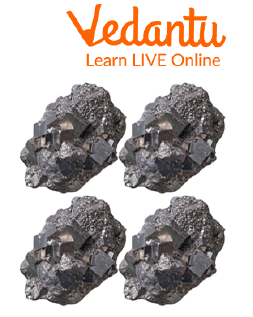




Why Is Iron Essential in Everyday Life?
The periodic table's group VIII element, iron, is a metal. It is a silver-grey colour and is glossy, ductile, and malleable. It ranks as the eighth most prevalent element in the cosmos. It is present in significant quantities in the molten form at the Earth's core.
For example, a nail can be made out of iron (Fe). Iron remains an element even after being sliced in half. You will still be holding the essence of iron if you keep cutting the nail until it is so tiny that you can hardly see it. Let’s now see more about it in detail.

Iron
Iron Metal Properties
Some properties of iron are as follows:
Iron has numerous characteristics that make it extremely beneficial in a variety of industries, from metallurgy to recycling. Although it is by no means exhaustive, the list below does give some information about some of the iron's characteristics:
Ferromagnetic Ability - this means that iron can form magnets or be attracted to magnets, which means it’s easier to separate it from non-ferrous materials.
Hardness - The degree of hardness of iron is one of its most well-known mechanical characteristics. Iron is a hard metal that may be utilized in a wide range of applications and industries. When mixed with other materials, iron becomes a very powerful metal.
Low Cost - Iron metal is also inexpensive, which makes it valuable for many global industries.
Malleability - Iron is malleable and may deform under pressure, such as when being hammered.
Dissolvable - Iron dissolves in dilute acids.
Conductivity - This element is a good conductor of heat and electricity and is also easily magnetic.
Uses of Iron
Some uses of iron are as follows:
It is used in the production of steel as well as the construction of girders and other reinforced concrete structures.

Bed Made from Iron
Steel, which is frequently utilised in industrial and civil engineering today, is created from iron. Stainless steel, which has strong corrosion resistance, is frequently used in cookware, appliances, and other kitchenware. It is also used in medical equipment.
Alloy steels, which are carbon steels with additions like nickel, chromium, vanadium, tungsten, and manganese, are made from iron.
Iron is used in a variety of everyday objects, such as tools, machinery, automobiles, ship hulls, building structural components, bridges, and aircraft.
These are utilized to create rifle barrels, bicycle chains, bicycle towers, and bridges.
Cast iron has a 3-5% carbon content. It's used in pumps, valves, and pipes.
In the Haber process, which creates ammonia, iron catalysts are used.
This metal, as well as its alloys and compounds, can be used to make magnets.
Iron Alloys
Due to its widespread availability, iron is a very significant and necessary element in our daily life. It is also an essential part of many alloys. The following are a few of the most popular iron alloys and the uses of iron alloys are as follows:
Steel- A material made of iron and carbon, is widely used in building, making weapons, and transportation.
Stainless Steel- It has extraordinarily high corrosion resistance and is produced by adding at least 10.5% chromium, is the ideal material for demanding conditions. This alloy is malleable, has low tensile strength, and is neither very brittle nor ductile.
Cast Iron - Made from pig iron and alloyed with silicon and carbon (3%-5%), cast iron is strong, light, and well-suited for use in a variety of applications.
Iron and Nickel - This combination makes an alloy that is more heat- and acid-resistant.
Iron and Manganese- This alloy is incredibly durable.
Iron and Tungsten - An alloy that can sustain hardness at high temperatures are created by mixing tungsten with iron.
Interesting Facts About Iron
Enjoy this collection of fascinating iron and steel facts. Discover the functions, qualities, and historical applications of iron and steel.
Iron is a metal and chemical element. Fe is its chemical symbol, and 26 is its atomic number.
On the Earth's surface, iron is rarely found in its pure metal state because it oxidizes so quickly. Instead, it is taken out of the ores (rocks containing important minerals and elements).
Puddle iron was used to construct Paris, France's Eiffel Tower. A type of wrought iron with an extremely low carbon content is called "puddle iron”. While wrought iron was widely used throughout Western history, it is no longer produced in considerable quantities because of the availability of steel.
Iron and steel can be painted, covered in plastic, galvanized (coated with zinc), or protected from rust damage using other techniques that keep out oxygen and water.
A lot of diverse items may be made out of iron, which are quite inexpensive to create.
Iron is frequently used in the construction of tools, cars, and buildings (usually in the form of steel).
Summary
This article on interesting facts about iron taught us that one of the transition elements is the metallic chemical element iron. The second most prevalent metal, the most accessible metal, and the fourth most prevalent element in the Earth's crust. Iron is the only metal that can be tempered because it is ferromagnetic at normal temperatures. It is used in a wide variety of steel products, including cast and wrought iron.
A diet high in iron is essential for optimal health since the human body contains about one-sixth of an ounce (4.5 g) of iron, mostly in the form of haemoglobin and its precursors. We hope you enjoyed reading this article.
FAQs on Interesting Facts About Iron: Concepts, Uses & Importance
1. What is iron and what are its most well-known properties?
Iron is a chemical element with the symbol Fe. It is a strong, hard, silvery-grey metal that is known for being the most common element on Earth by mass, forming much of our planet's core. Its key properties include being magnetic and its tendency to rust when exposed to air and moisture.
2. What are some of the most common uses of iron in our daily lives?
Iron is incredibly useful and is found all around us. Its main use is to make steel, which is an alloy of iron and carbon. Some common applications include:
- Construction: Used in making beams, pillars, and reinforced concrete for buildings and bridges.
- Transportation: Forms the body and engine parts of cars, ships, and trains.
- Household Items: Found in kitchen utensils, appliances, tools, and cutlery.
- Machinery: Essential for manufacturing industrial equipment and machines.
3. Why is iron important for the human body?
Iron is a vital mineral for our health. Its main function is to help create haemoglobin, a protein in red blood cells that carries oxygen from our lungs to the rest of our body. Without enough iron, you can feel tired and weak. You can find iron in foods like spinach, red meat, beans, and fortified cereals.
4. Where does the iron used in industries come from?
Most of the iron we use is not found as a pure metal. It is extracted from rocks called iron ores, with the most common ones being hematite and magnetite. This ore is mined from the ground and then heated in a large furnace, a process called smelting, to separate the pure iron from the rock.
5. Why does iron rust when left outside?
Iron rusts due to a chemical reaction called oxidation. When iron (Fe) is exposed to oxygen (O₂) and water (H₂O), it corrodes and forms a new, reddish-brown flaky substance called iron oxide, or rust. Rust is weaker than iron and can cause the metal to crumble over time.
6. How did the discovery of iron change human history?
The discovery of how to extract and work with iron marked a major turning point in civilization, leading to a period known as the Iron Age. Iron tools were much stronger and more durable than the bronze tools used before. This allowed for more efficient farming with iron ploughs, the creation of stronger weapons, and the construction of more advanced structures, completely transforming societies.
7. What makes iron so special compared to other metals like aluminium?
Iron has a unique combination of strength, abundance, and low cost that makes it different from other metals. While aluminium is lighter and doesn't rust, it is not as strong as steel (made from iron). Iron is also strongly magnetic, a property not shared by many common metals like aluminium or copper. This combination makes iron the most widely used metal in the world.
8. Is the iron in our blood the same as the iron used to make a nail?
Yes and no. At a chemical level, the iron atoms (Fe) are exactly the same. However, their form and function are completely different. In a nail, billions of iron atoms are bonded together to form a solid metal. In our blood, individual iron atoms are a crucial part of a complex molecule called haemoglobin, where they help transport oxygen. You cannot get your daily iron by eating a nail because our body cannot digest solid metal.
9. Why is Earth's core made mostly of iron?
Scientists believe Earth's core is mostly iron because of density. When the Earth was first forming and was a hot molten ball, heavier elements like iron and nickel sank towards the center due to gravity, while lighter elements like silicon and oxygen floated towards the surface to form the crust and mantle. Iron's abundance and high density made it the primary component of the planet's core.









